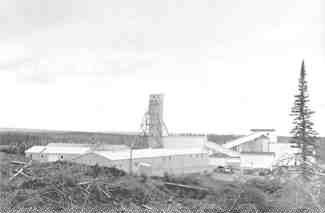The deal calls for Altius to issue 200,000 shares, as well as spend $500,000 over four years. Also, the company will have a right of first refusal on the southern part of the property and its mineral processing facilities.
The property was mined by Irving family-led Consolidated Rambler Mines from 1964 to 1982, during which time 4.7 million tons of copper-gold ore were extracted from four separate deposits.
“The mining never stopped for lack of ore,” says Altius President Brian Dalton. “It stopped for lack of ownership of the ore. Susan Blagdon, the principal of Ming, has done a remarkable job in cleaning up the ownership of the area and has let the geology and the potential jump to the forefront again.”
In the late 1980s, partners Petromet Resources and Newfoundland Exploration spent nearly $4 million exploring the property. However, their efforts were limited by the fact that they did not own the neighbouring property, which has since been consolidated into the current project package.
The Rambler joint venture focused on evaluating existing resources, metallurgical testing for the recovery of gold from the tailings area, and generating new targets. A new massive sulphide zone, called Ming West, was discovered in the northern part of the property, but it was determined to be too small for a stand-alone operation.
In 1993, Newfoundland-based Ming, then led by Samuel Blagdon, Peter Dimmel and former provincial premier Brian Peckford, acquired the project from Homestake Canada and set about refurbishing the mill. A 70% interest in Ming Minerals was vended into Ming Financial, which was initially listed on the Alberta Stock Exchange. The company was later renamed Eastern Meridian Mining.
The original plan was to mine the Ming West deposit and use the cash flow to refurbish the main Ming deposit at depth.
“There is still quite a bit of ore remaining at the bottom of the Ming,” confirms Dalton.
The Rambler mill was put back into commission in October 1995, and by June 1996 it had produced 5,250 tons of copper concentrate, 4,872 oz. gold and 24,028 oz. silver from 150,000 tons averaging 3.5% copper plus 0.05 oz. gold and 0.6 oz. silver.
Instead of sinking the money back into the Ming deposit, Ming/Eastern Meridian decided to buy the nearby Stog’er Tight gold property from Noranda.
A cyanide circuit was installed in the mill in the summer of 1996 to treat gold ore from a small zone on the property and from the Stog’er Tight property, 14 km from the mill. After struggling with lower-than-expected mining grades and recoveries, operations were suspended in January 1997 after only 3,000 oz. gold were recovered.
Several unsuccessful attempts were made to farm out the project before Eastern Meridian finally disposed of its holdings in Ming Minerals in May 2000.
Altius, a St. John’s-based exploration junior noted for its extensive portfolio of early-stage gold and base metal properties in Newfoundland, has reviewed various government and industry technical reports. The junior believes that several key targets exist at depth below the old Ming mine workings.
“We’ve done a lot of due diligence, re-logged a lot of core and completed some of the first-ever litho geochemistry samples on the property,” says Dalton.
Open at depth
The Ming deposit plunges moderately over a known distance of 5,700 ft. and reportedly produced 2.1 million tons grading 3.5% copper and 1% zinc, plus 0.07 oz. gold and 0.6 oz. silver per tonne. The massive sulphide body was mined down to the 2,600-ft. level, near the edge of the old property boundary. The deposit opens at depth beyond the old mine workings.
In the last year of mining, an exploration drift at the 1,807-ft. level revealed native gold mineralization in fractures along the deposit’s thinning margin. Continued drifting resulted in the discovery of a massive sulphide lens assaying up to 11.5% copper across 8.5 ft., adjacent to the neighbouring property boundary, about 600 ft. northwest of the Ming deposit. This 1807 zone will be targeted for drill-testing down-plunge across the edge of the former property.
Stringer zone
A sulphide stringer zone, averaging 120 ft. thick and sitting 300-400 ft. stratigraphically below the Ming deposit, is said to contain a sub-economic resource of about 11 million tons grading 0.9% copper. A past hole testing the down-plunge projection of the stringer footwall zone hit 131 ft. averaging 2% copper, including 55 ft. grading 2.89% copper and 0.02 oz. gold.
The next stage of exploration will consist of deep diamond drilling to test key targets. Altius will be eligible, under a Newfoundland government exploration incentive grant, for reimbursement of up to half of its drilling costs to a maximum of $100,000 per program.
With 13.1 million shares outstanding, Altius is trading at 73 in a 52-week range of $1-41. The company has $600,000 in working capital.


Be the first to comment on "Altius options Rambler property"